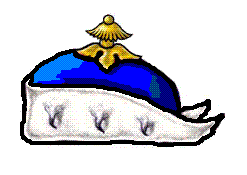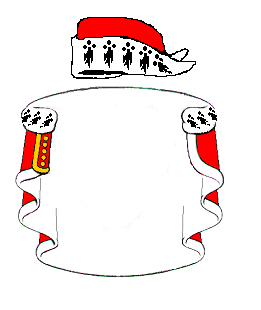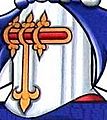Barons in Scotland facts for kids
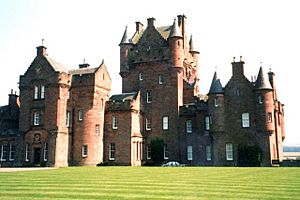
In Scotland, a baron or baroness is the leader of a special type of land area called a feudal barony. This title used to be connected to a specific piece of land that had an important building on it, like a castle or a large house. This building was known as the caput (which means "head" in Latin). So, the person who owned the land with the caput was called a baron or baroness.
Long ago, in the 13th century, the word "baron" was used to describe someone similar to a "knight of the shire" in England. Today, Scottish baronies are seen as a minor noble title, meaning they are a step below a peerage (like a Duke or Earl). Unlike some other noble titles, Scottish feudal baronies can be passed down to anyone, male or female, either through family inheritance or by being bought and sold.
Scotland has its own unique legal system, different from the rest of the United Kingdom. The Lord Lyon King of Arms is an important official in Scotland. He is like a judge for matters related to coats of arms and noble titles. He now recognizes these feudal barony titles based on old royal documents.
Contents
History of Scottish Baronies
For a long time, from 1660 until 2004, a "Scottish Prescriptive Barony by Tenure" was a special kind of noble title in the United Kingdom. It was unique because it could be bought and sold along with the caput (the main property), instead of only being passed down through family bloodlines.
Old laws from 1592 and the time of King Charles I show that Scottish barons ranked below Baronets and Knights, but above Lairds, Esquires, and Gentlemen.
In 1617, a public record system was set up for land ownership. If you were listed in this register for many years, you gained the right to the caput of a barony. This meant you became the baron or baroness. Later, in 1672, another register was created for coats of arms, making sure only valid arms were used in Scotland.
Until 1874, each new baron had their title confirmed by the Crown (the King or Queen) through a special document called a Charter of Confirmation. Before November 28, 2004, a barony was a piece of land held directly from the Crown or the Prince and Great Steward of Scotland. To be a barony, there had to be a Crown Charter that officially made the land a barony.
After the Treaty of Union in 1707, the British Parliament in Westminster made laws for both Scotland and England. But in 1999, the Scottish Parliament was created in Edinburgh. Now, Scotland can make its own laws about private land.
Old feudal grants allowed landowners to set up lasting rules for their land. These rules were called "real burdens" and were similar to how leasehold works in England.
End of the Feudal System
The Scottish government wanted to end the old feudal system. So, on November 28, 2004, a new law called the Abolition of Feudal Tenure etc. (Scotland) Act 2000 came into full effect. This law officially ended Scotland's feudal system.
Even though the feudal system ended, the title of baron was kept. It is now considered "incorporeal feudal heritage," which means it's a title that exists but isn't directly tied to owning land anymore. This makes it the only genuine noble title in the UK that can still be bought and sold. However, you can no longer get feudal land rights just by inheriting or buying the caput (land or castle).
One of Scotland's oldest baronies, the Barony of the Bachuil, is special. For centuries, it hasn't depended on land ownership. This barony is passed down with an ancient stick called "The Bachuil Mór." This stick was once the staff of Saint Moluag in the year 562. The person who lawfully owns the stick is the Baron of the Bachuil, no matter what land they own.
Since the 2004 law, the Lord Lyon, who is Scotland's chief herald, has changed how a baron's coat of arms looks. Barons are now recognized by a specific type of helmet on their coat of arms.
If you hold a barony title, you can ask the Lord Lyon for a grant of arms. The Lyon Court, however, does not handle the legal transfer of feudal titles.
How Scottish Baron Titles Are Used
An English barony is a peerage title, which is a higher rank of nobility. But Scottish barons are considered "minor barons," meaning they are noble but not part of the peerage. The Scottish equivalent of an English baron is a "Lord of Parliament."
A feudal barony title is often used by a family that owns land but doesn't have a higher UK peerage title or hasn't been made a knight. The name recorded by the Lord Lyon for a coat of arms becomes the official name for the title holder.
The holder of a Scottish barony (for example, "Inverglen") can add the title to their name. For instance, they might be called "John Smith, Baron of Inverglen" or "Jane Smith, Baroness of Inverglen." If they still own the main property of the barony, they can add the place name to their surname, like "John Smith of Inverglen, Baron of Inverglen." Some very old Scottish families prefer to be called just by the place name, like "Smith of Inverglen."
Formally, in writing, they are called "The Much Honoured Baron/Baroness of Inverglen." Socially, they can be addressed as "Inverglen" or "Baron/Baroness." When introduced, they might be called "John Smith of Inverglen, Baron of Inverglen" or "The Baron of Inverglen." It's not correct to call them "Baron/Baroness Inverglen" or "Lord/Lady Inverglen," as those names usually mean a peerage title.
If a husband holds the barony, his wife gets a courtesy title. They might be called "The Baron and Baroness of Inverglen" or "The Baron of Inverglen and Lady of Inverglen." The oldest son of a baron or baroness can use "yr" (for "younger") after his name, like "John Smith of Inverglen, yr." The eldest daughter might be called "Maid of Inverglen" at the end of her name. The husband of a Baroness does not get a courtesy title.
For passports in the United Kingdom, if you want to include your title, you need to show proof that the Lord Lyon has recognized your feudal barony. If accepted, the place name of the barony can be added to your surname (e.g., "Smith of Inverglen"). The passport will then show your full name and your feudal title (e.g., "The holder is John Smith, Baron of Inverglen").
Scottish Heraldry
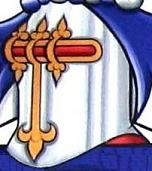
The Lord Lyon now officially recognizes feudal barons who meet certain requirements. They can be granted a coat of arms with a special helmet that shows their rank. Scottish Barons are noble, but they rank below Lords of Parliament.
An important legal decision from 1943 stated that "Minor Barons of Scotland are, and have been recognized as 'titled' nobility." This means they are part of Scotland's ancient feudal nobility.
A book called 'Scots Heraldry' explains that "Nobles" (peers) are the highest, followed by "Barons" (lairds of baronial lands), and then "Gentlemen" (other people with coats of arms). This shows that barons are considered a higher rank than baronets and knights.
Barons may also wear two eagle feathers when wearing traditional Scottish clothing. If a baron is part of a clan, they should check with their clan chief about customs for wearing feathers.
Chapeau
Before 2004, when a new coat of arms was granted to a baron, they might have received a chapeau (a cap of maintenance) as part of it. This chapeau was usually red with white ermine fur for barons who owned the main property of the barony. A blue chapeau was used for heirs of old baronial families who no longer owned the estates. This was a newer addition to heraldry. Now, it is no longer granted.
There is a special exception for the Barony of the Bachuil. This barony is very old (from 562 A.D.) and existed before Scotland's feudal system. Because of its unique history, the Baron of the Bachuil is the only one allowed to have a chapeau with a vair (squirrel fur) lining.
If a chapeau is part of a coat of arms, it is placed above the shield and below the helmet. It can also be used on things like visiting cards.
Feudo-Baronial Mantle
A special Scottish feature was the feudo-baronial mantle or robe. This was a red silk robe lined with silver, with fur edges and an ermine collar. It could be shown draped behind the coat of arms, topped with the chapeau. However, the Lord Lyon no longer grants these heraldic mantles.
Helmet
The helmet is now the main way to recognize a Scottish baron on a coat of arms. The Lord Lyon has decided that a steel helmet with three gold bars is the correct symbol for a baron. Sometimes, an old-style steel tilting helmet facing forward can be used. If a baron holds a higher rank, like a Lord of Parliament, they would use a helmet that shows that higher rank.
Supporters
Supporters are figures (like animals or people) that stand on either side of the shield in a coat of arms. They are usually given only to holders of older baronies (created before 1587) and those that have stayed in the same family for a long time. In England, supporters are only for peers. A compartment (a base for the supporters) is sometimes granted to barons, representing their lands, even if they don't have supporters.
Badge
A badge is a separate symbol from the main crest on a coat of arms. It can be used by the followers of a landowner baron. The badge is often shown on the baron's standard, which is a special flag in the baron's colors. The standard is described in the official grant of arms. The colors usually come from the main colors of the coat of arms.
Flags
- A Standard is a long, tapering flag. Its length depends on rank, from 7.5 meters for the King or Queen down to 3.5 meters for a Knight, Baron, or Chief. It shows the coat of arms or the Scottish saltire flag at the hoist (the part closest to the flagpole). It also features the crest, badge, or supporters, and the motto. A Standard is placed in front of the baron's tent (like a headquarters flag) and is not carried like a banner. You need a separate grant from the Lord Lyon to have a Standard.
- A Guidon is shorter than a Standard and has a rounded end. These are given to people who have Supporters on their Arms, or to others who have followers or an official position.
- A Pennon is a smaller, elongated flag, about 4 feet long, with a pointed or rounded end. It's designed to be displayed on a lance. It shows the motto and the coat of arms.
- A Banner is a square or rectangular flag that shows the coat of arms. It was originally used in battles or tournaments, but now it's flown as a "house flag" when the person with the arms is at home. It is NOT the flag of the whole Clan or Family.
* Square banners have specific sizes: The King/Queen's is 1.5 meters square; Dukes' are 1.25 meters square; Earls' are 1.1 meters square; Viscounts and Barons' are 1 meter square; Baronets and feudal barons are 0.9 meters square; and other armigers' are 70 cm wide by 85 cm high. * Rectangular banners are usually 3:2 or 5:4 in proportion when used as a house flag. * Carrying flags also have specific sizes: Peers' are 1.2 m x 1.5 m; Feudal Barons are 90 cm x 115 cm; Chiefs' are 85 cm x 110 cm; and Chieftains' are 80 cm x 90 cm.
- An Ensign is a square flag, smaller than a flying banner. It shows the full embroidered coat of arms (arms, crest, motto) and is usually fringed in the colors of the arms.
- A Pipe banner is similar to a Banner but is sized to fit on the longest drone of bagpipes (usually 45 cm). It is richly decorated. A pipe banner for a Chief who is also a Peer or a Feudal Baron should have a rounded end that extends beyond the length. A feudal baron is allowed to have two pipers.
See also
- Commissioner (Scottish Parliament)
- Laird
- List of extant baronetcies
- Feu
- Feudal earldom
- Scottish feudal lordship
- Lord of Parliament
- English feudal barony
- Irish feudal barony
- List of Marcher lordships (Welsh Marches)
Images for kids


